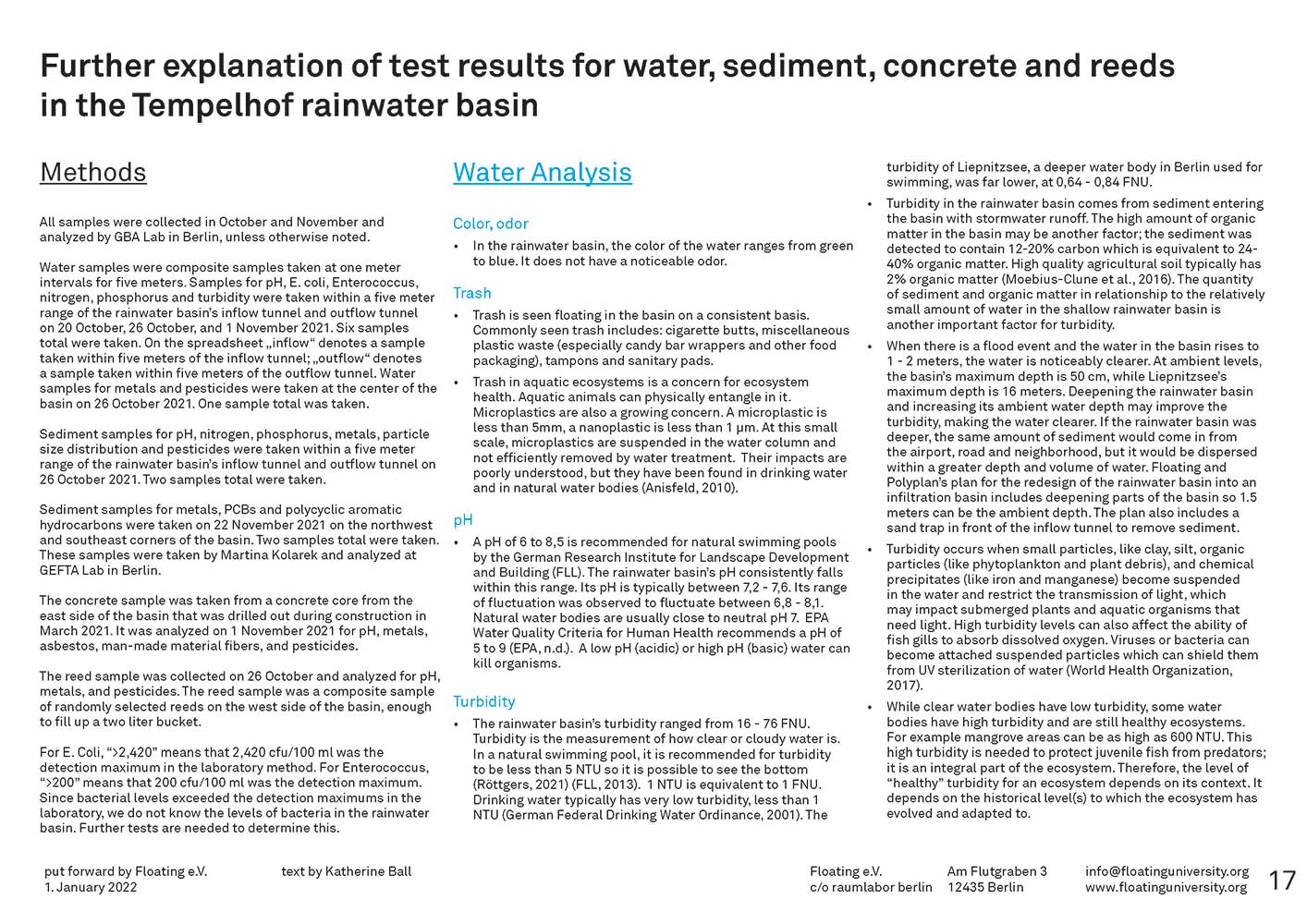Results Wateranalysis
Introduction
Poor water quality degrades aquatic ecosystems, constrains human uses of water, and negatively impacts human well-being. In autumn 2021, a series of tests on water, sediment, plants, and concrete were performed in the rainwater basin adjacent to Tempelhofer Feld, where Floating University is located. The text below goes through some of the most important water quality parameters. It situates them in the context of the rainwater basin. It explains what the test results are, what they mean, and why they are significant. The tests were performed at GBA Lab in Berlin.
Summary of the results
What we learned from the water tests is the water in the rainwater basin is not highly polluted. Some of the parameters we tested are within the regulatory criteria for swimming, aquatic organisms and ecosystem health. Some meet the criteria for drinking water. The parameters that meet the standard criteria are: color, odor, pH, nitrogen, pesticides, and metals – arsenic, cadmium, nickel, mercury, and silver, when compared with appropriate reference criteria.
Some parameters are concerning. They are too high for swimming or aquatic organisms and ecosystem health. These parameters of concern are: bacteria, turbidity, phosphorus, lead, zinc, polycyclic aromatic hydrocarbons, and trash. These parameters would need to be addressed within the design and carefully monitored in order ensure aquatic ecosystem health or to be able to swim in the water.
- Bacteria: E. Coli ranges from 165 to >2.240 cfu/100ml. It needs to be below 500 for swimming, according to the EU Bathing Directive.
- Bacteria: Enterococcus ranges from 165 to >200 cfu/100ml. It needs to be below 200 for swimming, according to the EU Bathing Directive.
- Phosphorus (a nutrient that can encourage algae to grow) ranges from 0,15 – 0,66 mg/L in the basin. For natural swimming pools, phosphorous should be less than 0,01 mg/L.3 for swimming by the EU Environment Agency – even in Liepnitzsee the phosphorus was also too high, it was 0,061 – 0,11 mg/L
- Lead in the water is 5.6 micrograms/Liter. The maximum for drinking water is 5 micrograms/L, according to the EU Drinking Water Directive. (There is no maximum listed for swimming under the EU Bathing Directive.)
- Zinc has accumulated in the basin’s sediment in amounts of 2000 – 2490 mg/kg. Unpolluted, natural lakes typically have less than 140 mg/kg.5 For the health of organisms that live in sediment, it is important to have less than 190 mg/kg.
- In the concrete, no asbestos or man-made material fibers (MMMF) were detected. Heavy metals in the concrete are at low levels and not concerning. This means that if the concrete is removed, there should not be a concern about toxins being released from the concrete.
- Trash is consistently observed in the rainwater basin, which currently drains to the Spree River. Microplastics are a growing concern. Their impacts are poorly understood, but they have been found in drinking water and in natural water bodies.
Reference criteria were derived from the EU Directives for Bathing Water (2006/7/EC), Drinking Water (2020/2184) and Environmental Quality (2008/105/EC); German Federal Ordinance for Drinking Water (TrinkwV), Soil Protection and Contaminated Sites (BBodSchV); German Research Institute for Landscape Development and Building (FLL); and US EPA. For some results, a reference lake was tested, Liepnitzsee – a lake in Berlin-Brandenburg of “excellent” swimming quality rated under the EU Bathing Water Quality Standards10 – to provide a comparison to the rainwater basin.












